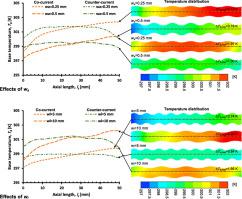International Journal of Thermal Sciences ( IF 4.9 ) Pub Date : 2021-07-28 , DOI: 10.1016/j.ijthermalsci.2021.107189 M. Khoshvaght-Aliabadi 1 , A. Abbaszadeh 1 , M.M. Rashidi 2, 3

|
This study aims to make a comprehensive comparison between the applications of co- and counter-current modes in the wavy minichannel heat sinks (WMHSs). In this regard, the effects of wave-amplitude (wa) and wave-length (wl) are studied at different levels. Water is used as coolant over the Reynolds number (Re) range of 100–900. Nusselt number ratio, friction factor ratio, performance index, max. base temperature difference, and pumping power are reported as quantitative results. An experimental study is also carried out to establish required data for the validation. The outputs illustrate that for both the current modes, the dependence of thermal and hydraulic characteristics on Re increases with increasing wa and decreasing wl, while the counter-current mode is more impressed by the increase of Re compared to the co-current mode. In summary, the Nusselt number ratio ranges from 1.22 to 2.96 for the co-current mode and from 1.23 to 3.17 for the counter-current mode, and the friction factor ratio ranges from 1.09 to 2.73 for the co-current mode and from 1.10 to 2.92 for the counter-current mode, and the range of performance index is from 1.18 to 2.12 for the co-current mode and from 1.19 to 2.22 for the counter-current mode. Eventually, it is found that at the same pumping powers, replacing the co-current mode with the counter-current mode can significantly boost the temperature uniformity in WMHS. The max. base temperature of about 0.84 K is recorded for WMHS with wl = 5 mm at Re = 900. It is worthy to note that the superiority of the counter-current mode increases with increasing wa and decreasing wl.
中文翻译:

波形微通道散热器 (WMHS) 的顺流和逆流操作模式的比较
本研究旨在对顺流和逆流模式在波浪形微通道散热器 (WMHS) 中的应用进行全面比较。在这方面,在不同层次上研究了波幅(w a)和波长(w l)的影响。在 100–900的雷诺数 ( Re ) 范围内,水用作冷却剂。努塞尔数比、摩擦系数比、性能指标、最大值 基础温差和泵浦功率作为定量结果报告。还进行了一项实验研究,以确定验证所需的数据。输出表明,对于两种电流模式,热和水力特性对Re的依赖性随着w a 的增加和w l 的减小而增加,而Re的增加对逆流模式的影响更大与并流模式相比。总之,并流模式的努塞尔数比范围为 1.22 至 2.96,逆流模式为 1.23 至 3.17,摩擦因数比范围为并流模式为 1.09 至 2.73,而摩擦因数比范围为 1.10 至 3.17。逆流模式为2.92,并流模式的性能指标范围为1.18至2.12,逆流模式为1.19至2.22。最终发现,在相同的泵浦功率下,用逆流模式代替并流模式可以显着提高 WMHS 的温度均匀性。最大。WMHS 记录的基本温度约为 0.84 K, 在Re处w l = 5 mm = 900。值得注意的是,逆流模式的优越性随着w a 的增加和w l 的减小而增加。











































 京公网安备 11010802027423号
京公网安备 11010802027423号